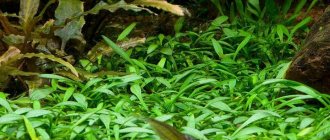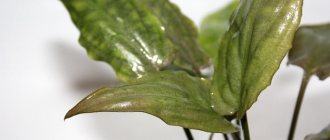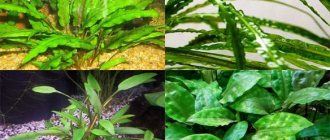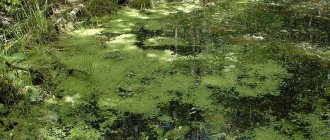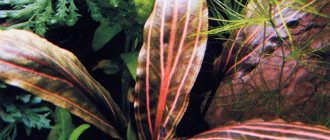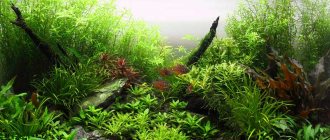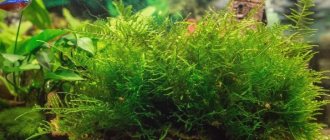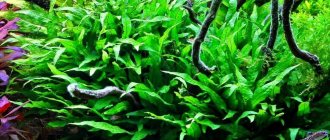Beckett's Cryptocoryne, or Petch's Cryptocoryne Petchii, is one of the species of aquatic plants that is very easily confused with some varieties of Wendt's Cryptocoryne, due to the fact that their leaf color and size directly depend on environmental conditions. The main difference is the height of the plant: Cryptocoryne Petsch is somewhat smaller and reaches a height of 15 cm.
This species is naturally distributed in the waters of Sri Lanka, New Guinea and India. In addition, this species of Cryptocoryne was introduced into quiet rivers and lakes of North and South America. As for the use of Cryptocoryne Beckett in aquarium design, this species has not found wide demand among aquarium hobbyists. Nevertheless, Cryptocoryne Petsch is quite unpretentious in care, and if all the conditions are created for it, then it grows and expands quite quickly in the aquarium.
Content
- 1 Description
- 2 Terms
- 3 Ground
- 4 Recommendations
- 5 Features
- 6 Reproduction
Source: life.toata.info
Source: aquahome.info
Source: www.aqua-fishka.ru
- Other names: Cryptocoryne beckettii, Cryptocoryne petchii, Cryptocoryne petchii, Cryptocoryne petchii, Cryptocoryne Beckett.
- Origin: Southeast Asia, Sri Lanka.
- Size: 10-25 cm.
- Temperature: 20-30 °C.
- Water parameters: pH 6-8, dKH 6-10 °.
- Lighting: from 0.6 W/l.
- Growth rate: slow.
- Content difficulty: easy.
Reproduction
In general, it is quite difficult to achieve reproduction of some species. Often, aquarists resort only to the vegetative type. When a new shoot appears on the mother bush, it is not touched at first. It feeds, grows, and when about 5-6 leaves have already grown on it, it can be safely separated and replanted.
As for propagation through seeds, this is an almost unrealistic process in aquarium conditions. Cryptocoryne rarely blooms at home, and accordingly, it is extremely difficult to get babies.
Description
An attractive, interesting plant. Due to its compactness and low height, it is quite suitable for any place in the aquarium: it will look good in the foreground, middle and background.
The plant has several varieties, so the color and shape of the leaves may vary. The leaves are collected in a rosette, wavy at the edges, rounded or heart-shaped at the bottom, pointed at the top. The upper part can be olive brown, olive green, bright green, the lower part can be red-brown, violet-red, pinkish-purple.
Peculiarities
All cryptocorynes have one small feature. They suffer from what is called “cryptocoryne disease.” It's not scary and it's not really a disease, it's just a name. The plant reacts this way to a sudden change in water parameters, sometimes this can be caused by physical damage to the leaves or algae.
But it doesn’t look nice: the leaves lose their rigidity, become soft, uneven, gelatinous and lose their structure and begin to disintegrate. There is no need to do anything about this, the plant adapts to new conditions in this way, new leaves will appear on their own over time.
To avoid this, do not allow sudden changes in water parameters. For example, reduce the volume of substitutions. If it's algae, try to get rid of it.
Cryptocoryne Beckett
Homeland - the island of Sri Lanka.
Cryptocoryne beckettii is a herbaceous amphibian plant, a species of the genus Cryptocoryne beckettii of the Araceae family.
Perhaps one of the most popular plants with excellent decorative qualities. The leaves of Cryptocoryne Beckett are dark olive in color with a reddish-brown underside. The plant reaches 10-12 cm in height. Place cryptocoryne in the foreground and middle ground of the aquarium.
Cryptocoryne Beckett photo
Comfortable water parameters for keeping Beckett's cryptocoryne : 24-28 °C (in colder water its growth slows down). Hardness ranges from 8-16°. The active reaction must be neutral or slightly alkaline - pH 7+. With increased acidity, the plant may lose all its leaves.
Recommended lighting: moderate or fairly strong, always diffused. The plant grows well in the light shade of tall plants. Daylight should be 11-12 hours. Lighting intensity from 50 Lm/l.
The substrate is coarse river sand or very small pebbles. The soil should be sufficiently nutritious; a substrate is desirable. It is recommended to add peat, coal, and fertilizer tablets to the new soil, for example, Tetra PlantaStart and Tetra Crypto .
Cryptocoryne Beckett photo
The plant is easily propagated by root layering. Daughters with 3-4 leaves can be separated from the mother plant.
Cryptocoryne is able to grow in a paludarium, in which the plant develops much faster than in an aquarium.
We recommend that you read the full and extensive article about CRYPTOCORYNES!
Cool videos about plants from FanFishki
Subscribe to our YouTube channel so you don't miss anything
PRACTICAL NOTE ON GROWING AQUARIUM PLANTS
This note is posted in all FanFishka articles dedicated to aquarium plants. This is a cheat sheet with a link that will help you grow any aquarium plant and herbalist of any complexity.
Most of the reference materials are located in the Aquascape , we also recommend our brochure: Aquarium navigator for beginners: “Underwater Gardens of Babylon” .
The formula for success in growing plants can be depicted as follows.
First of all, the proper level of lighting is necessary.
(light intensity - Lumens)
Next, the proper concentration of CO2
Further macro-fertilizers and micro-fertilizers
Water parameters, care and quality water changes
The gradation of this formula is based on the degree of importance. Lighting intensity is primary, and then descending. Therefore, if your plants have holes in the leaves, they have sciatica (crooked) or there are problems with algae, then please do not read the “bad advice” - this is chlorosis (lack of iron), this is a lack of potassium... diarrhea, phimosis and endometriosis )
You always need to solve the problem of setting up an herbalist from major to minor. Plants will die more quickly from a lack of lighting than from a lack of Fe and K. Moreover, the latter are always present in one degree or another in the aquarium, but it is difficult to measure their precise value.
Below, let's go from the main to the minor.
Lighting in an aquarium with plants . Remember, the most important thing in light is its intensity (Lumens)! All other lighting characteristics: spectrum, Kelvin, PAR/PAR, Ra... are important, but secondary. There will be no intensity of lighting, there will be nothing. At the same time, the lighting intensity must be balanced - selected specifically for your project (height of the water column, number and types of plants, daylight hours).
Based on the above, choose aquarium lighting primarily by the number of lumens, and then everything else.
Lighting is the most expensive part. The most budget-friendly solution is to install ordinary construction-street floodlights above the aquarium . Fortunately, they are now very thin and aesthetic. And believe me, under them everything grows with a bang, of course, provided that all the other components are present.
In order not to be unfounded, here are photos of our herbalists, which were grown exclusively under LED spotlights or with their presence.
If you want professional lighting or aesthetics. Then you will have to fork out some money. The amounts can vary quickly from 10,000 to 50,000+ rubles for a 100 liter aquarium. For example, in 2021 we switched to professional lighting - ISTA Titan . Yes, not cheap, but the lamps are Achon! We have grown a professional competitive aquascape under them. That’s why we advise you to pay attention to them.
Well, it’s difficult to advise anything, because... Everyone has different needs and capabilities. In this article we talk about the products of our partners - Tetra , Laguna , ISTA lighting .
We tried to briefly and objectively talk about them. Then it's up to you. In any case, we do not really recommend that you pay attention to handicraft lighting assembly from folk craftsmen. Not all, but as a rule, they shove who knows what kind of diodes into such an assembly, assemble it all on their knees... and believe me, more than once on the forum you hear echoes of the consequences of such a purchase. After all, a company is a company. At a minimum, you are given warranty and post-warranty service.
If you are a beginner, your first herbalist, then LED spotlights are your choice. Let's move on, otherwise this note isn't very short =)
CO2 for aquarium plants . The plant is approximately 90% water, the remaining 10% is dry matter. Of that 10%, 46% is carbon. This is why CO2 supply is so important in a planted aquarium.
Plants in an aquarium obtain carbon “from water” - from carbon-containing compounds. But the natural concentration of C-carbon in water is small and is only sufficient for unpretentious plants, but they, and even more so, will be happy with additional carbon feeding. The supply of CO2 can be provided using mash or a CO2 balloon system , lemon juice or other methods.
The best, professional, simple and budget option is to supply carbon dioxide through a cylinder. One thing, however, is the initial purchase of a set: a cylinder, an MG valve, a diffuser…. will hit the budget.
Is it possible to do without CO2, but for a couple of bushes of simple plants ( cryptocorynes , echinodorus , most ludwigias , etc.).
What balloon systems can you recommend? The most budget option is an assembly from craftsmen who sell CO2 systems in VK and on forums. Everything is very high quality.
If you want a branded item, then we recommend the most inexpensive and at the same time high-quality CO2 systems from ISTA (Taiwan) . We have been using them for 5 years and recommend them to you.
On sale you will find two series of ISTA Aluminum CO2 Cylinder cylinders, with horizontal and vertical threads of 1 and 3 liters.
Fertilizers for an aquarium with plants . All fertilizers, of any brand, can be divided into MACRO-FERTILIZERS and MICRO-FERTILIZERS .
Macro fertilizers are nitrate NO3 and phosphate PO4 from which plants take N-nitrogen and P-phosphorus. These are the most important elements after CO2 - C-carbon.
Remember - Redfield's proportion rules . Always keep it under control and everything will be ok. Right, based on our observations, Redfield’s proportion rules only in full NPC proportions. Incomplete proportion - without carbon C does not give good results.
Micro fertilizers . These are all the other less important elements that are necessary for plants (see link). There is no point in putting too much emphasis on them. Firstly, all of them are contained in one quantity or another in tap water and are restored in the aquarium with changes. Secondly, an overdose of micro very quickly leads to an outbreak of algae.
A common mistake made by beginners is not understanding what they are pouring into the aquarium. For example, let's take such a popular and popular fertilizer as Tetra PlantaMin . Read the product summary at the link - it strengthens, stimulates, and gives a chic body shape.
A beginner, without delving into the essence, uses it and gets an outbreak of algae, writes on the forums - “Like, wow, what a bad Tetra.” And the trouble lies not in the drug, but in a lack of understanding of the nitrogen cycle and balance in the herbalist . The beginner has a Redfield bias (let’s say N and P are generally zero) and instead of making up for the lack of these primary elements, he fills the aquarium with Tetra PlantaMin - a micro-fertilizer (iron, potassium, manganese). As a result, going over the micro is only detrimental, because... plants lack the base - nitrogen and phosphorus.
Thus, you must understand what plants lack and understand fertilizers.
How to understand what plants lack? It's simple. Now the market is filled with a variety of expensive and not so expensive aquarium water tests. We recommend inexpensive domestic ones - VladOx drop tests , they are sold online and offline.
We also recommend, let’s not be afraid of this word, innovative domestic UHE tests . They are currently only sold online.
The minimum set of tests for an herbalist is NO3 and PO4. It is advisable to have the entire nitrogen range: NH4, NO2, NO3. As well as kH and pH tests.
Tests help us monitor the situation in the herbalist, but over time it is advisable to learn to see and feel the aquarium for yourself. With experience you need to move away from “convulsive testing”; the best aquarium test and tool is ourselves.
Let's summarize this part. Macro, it’s macro in Africa too. The link above generally contains a recipe on how to make them yourself. If you are not yet ready for self-mixing, then always and everywhere you will find a line of fertilizers from Tetra: Tetra Planta Macro , Tetra PlantaMicro , substrates, root tablets and much more .
Of course, there are many other brands that produce aquarium fertilizers. There is an opportunity, use even ADA products. All markers are different in taste and color. The main thing is to use it with a clear understanding of what you are using it for and what you want to get in the end.
From the professional line of fertilizers, at an adequate price, we can recommend Prodibo (soils, soils, macro, micro, stimulants, etc.).
So, something like a note turns into the Talmud. Which is not surprising - the topic is very broad. One moment left.
Water parameters for aquarium plants. Link1 and Link2 , please look at these articles, they cover the essence quite well.
Here we note that the quality of photosynthesis is influenced by the process of caring for the aquarium: water parameters (kH, pH below 7), high-quality filtration and aeration, competent and timely water changes.
Please study



